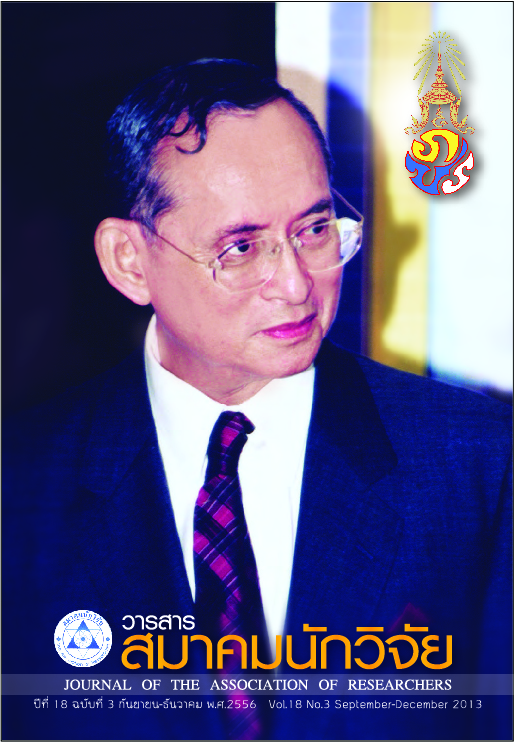SA-PA-JOKE: An Innovative of Political Edutainment
Main Article Content
Abstract
SA-PA-JOKE, an innovation of political entertainment broadcast on public television, provides
an opportunity to study the political, economic, and social contexts which affect its production. Research
can also focus on the process of innovation through the convention of David K. Berlo’s S-M-C-R communications
model (S-Sender, M- Message, C-Channel, R-Receiver) by studying the effects of Sa-Pa-
Joke as a means to communicate political information through entertainment, Such knowledge could
then be used to improve the program’s format so that it is more entertaining and conforms to audience
demands, based on data collected by questionnaire, which, in turn, relates to improving their perceptions
of the news.
Information about audience attitudes toward the program was collected by administering a
questionnaire to 1,688 people aged 18 years and older who lived in Bangkok and the surrounding area.
Additional information was collected by questionnaires and in-depth interviews with target groups, including
academicians, eight experts in mass communication, eight specialists and producers in the
entertainment industry, and 18 participants in the SA-PA-JOKE television program. Triangulation was
used as a qualitative check by considering the different data sources mentioned above.
The research results found that many factors affected the production of SA-PA-JOKE. These
factors included the format of the program, producers and participants in SA-PA-JOKE, the content of
the program, the benefits of improving the democratic system of government and the managing strategies
that inflfflluence the production of SA-PA-JOKE. The research also found that factors inffllfluencing the
program were the format of the program, which was different from other entertainment programs, the
moderator, the participants and the content of the program as it presented news or information about
stressful topics related to politics and the economy in an enjoyable way.
Article Details
บทความที่ปรากฏในวารสารนี้ เป็นความรับผิดชอบของผู้เขียน ซึ่งสมาคมนักวิจัยไม่จำเป็นต้องเห็นด้วยเสมอไป การนำเสนอผลงานวิจัยและบทความในวารสารนี้ไปเผยแพร่สามารถกระทำได้ โดยระบุแหล่งอ้างอิงจาก "วารสารสมาคมนักวิจัย"
References
จินตนา บุญบงการ และ ณัฏฐพันธ์ เขจรนันทน์. (2544). การจัดการเชิงกลยุทธ์. กรุงเทพมหานคร: ซีเอ็ดยูเคชั่น.
จิราภรณ์ เจริญเดช. ( 2548 ). การแปลงสิทธิอำนาจตามรายการวิทยุนายก ฯ ทักษิณ คุยกับประชาชน ศึกษากรณี
วิกฤตความรุนแรง 3 จังหวัดชายแดนภาคใต้. วารสารศาสตร์มหาบัณฑิต มหาวิทยาลัยธรรมศาสตร์,กรุงเทพมหานคร.
ฐิตินัน บุญภาพ. (2542). วิสัยทัศน์โทรทัศน์ไทย หลังปี ค.ศ.2000 (พ.ศ. 2543-2568). วิทยานิพนธ์ วารสารศาสตรมหาบัณฑิต สาขาวิชาสื่อสารมวลชน บัณฑิตวิทยาลัยมหาวิทยาลัยธรรมศาสตร์
นันทนา นันทวโรภาส. (2548). การสื่อสารทางการเมือง : ศึกษากรณี การรณรงค์ หาเสียงเลือกตั้งทั่วไปของพรรคไทยรักไทย. ปรัชญาดุษฎีบัณฑิต มหาวิทยาลัยธรรมศาสตร์, กรุงเทพมหานคร.
นันทิยา หุตานุวัตร และ ณรงค์ หุตานุวัตร. (2542). SWOT การวางแผนกลยุทธ์ ธุรกิจชุมชน. ฝ่ายผลิตและบริการเอกสาร สำนักวิทยบริการ มหาวิทยาลัยอุบลราชธานี.
นิวัติ โชติวงษ์. (2544). เครื่องมือและแนวคิดทางการบริหารจัดการเชิงกลยุทธ์. กรุงเทพมหานคร: รอยัลเพรสแอนแพค.
บุญเลิศ เย็นคงคา. (2547). การจัดการเชิงกลยุทธ์. กรุงเทพ: วี.เจ.พริ้นติ้ง.
ประยุทธ วรรณอุดม และ มงคล คำดวง. (2547) . ศักยภาพและกลยุทธ์การสื่อสารเพื่อการพัฒนา
ท้องถิ่นแบบสาระบันเทิงของหมอลำ. สำนักงานกองทุนสนับสนุนการวิจัย , กรุงเทพมหานคร.
ปาริชาต สถาปิตานนท์ สโรบล, กิตติ กันภัย, กาญจนา แก้วเทพ. (2543). มองสื่อใหม่ มองสังคมใหม่.คณะนิเทศศาสตร์ จุฬาลงกรณ์มหาวิทยาลัย , กรุงเทพมหานคร .
พัทธนันท์ เด็ดแก้ว. (2544). การศึกษาเปรียบเทียบการรับชมรายการโทรทัศน์ประเภทสาระความรู้และสาระบันเทิง
การจดจำได้ และการนำไปใช้ประโยชน์. นิเทศศาสตร์มหาบัณฑิต, จุฬาลงกรณ์มหาวิทยาลัย, กรุงเทพมหานคร.
ภูมิพลอดุลยเดชมหาราช, พระบาทสมเด็จพระปรมินทรมหา. (2518). พระราชดำรัส. ค้นเมื่อ 7เมษายน 2553, จาก http://www.siamtv.us/detail/tv5history.html),http://www1.mod.go.th/opsd/dstcweb/gst/img/S9.pdf
สมชาย ภคภาสวิวัฒน์. (2548). การบริหารเชิงกลยุทธ์.กรุงเทพ: อมรินทร์.
สมยศ นาวีการ. (2543). การบริหารเชิงกลยุทธ์และนโยบายธุรกิจ. กรุงเทพมหานคร: บรรณกิจ
สุรพงษ์ โสธนะเสถียร. (2545). หลักและทฤษฎีการวิจัยทางสังคมศาสตร์. กรุงเทพมหานคร: ประสิทธิภัณฑ์แอนด์พริ้นติ้ง.
สุรพล วิรุฬหรักษ์, เจนภพ จบกระบวนวรรณ, และบุญเลิศ นาจพินิจ. (2539). ลิเก. สำนักงานคณะกรรมการวัฒนธรรมแห่งชาติ, กรุงเทพ.ฯ
เสถียร เชยประดับ. (2551). การสื่อสารการเมือง และประชาธิปไตยในสังคมพัฒนาแล้ว . กรุงเทพมหานคร:จุฬาลงกรณ์มหาวิทยาลัย, กรุงเทพมหานคร.
Bandura, A. (1977). Social learning theory. Englewood Cliffs, NJ: Prentice-Hall.
Berlo, D. K. (1960). The process of communication: An introduction to theory and practice.
New York: Holt, Rinehart and Winston,
Kaid, L. L., Gerstlé, J. & Sanders, K. R. (Eds.). (1991). Mediated politics in two cultures: Presidential
campaigning in the United States and France. New York: Praeger.
Martilla, J. & James, J. (1977). ‘Importance-performance analysis’. Journal of Marketing, 41(1), 77-79.
Mc Quail, D. (1986). Diversity in political communication: Its sources, forms and future. In P. Golding,
G. Murdock & P. Schlesinger (Eds.), Communicating politics: Mass communications and the
political process (133-149). Leicester: Leicester University Press.
Mc Nair, B. (1999). An introduction to political communication. New York: Rout ledge
Singhal , A., & Rogers, E. M. (1999). Entertainment-Education: A Communication Strategy for Social
Change. Mahwah, NJ: Lawrence Erlbaum Associates
Singhal, A., Cody, M. J., Rogers E. M., & Sabido, M. (Eds.). (2004). Entertainment-Education and social
change. New Jersey: Lawrence Erlbaum associates.


